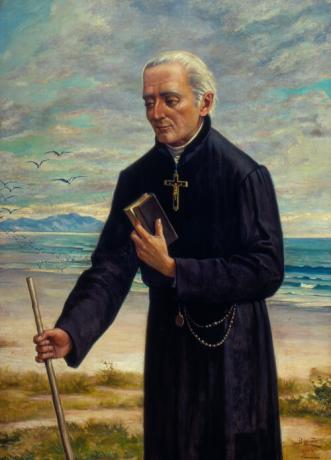José de Anchieta he was born on March 19, 1534, in San Cristóbal de la Laguna, Spain. Later, he studied at the Colégio das Artes, in Coimbra, and joined the Society of Jesus. He arrived in Brazil on July 13, 1553, with the mission of catechizing the Indians.
The priest used his poetry and plays to help convert indigenous peoples to Catholicism, in addition to writing the first Tupi grammar. After his death on June 9, 1597, in Reritiba, Espírito Santo, he was beatified in 1980 and finally canonized in 2014.
Read too: Luís Vaz de Camões – author considered the greatest poet in the Portuguese language
Biography of José de Anchieta

José de Anchieta was born on March 19, 1534, in San Cristóbal de la Laguna, in Spain. His father—Juan de Anchieta—was a royal scribe. Later, in 1548, the young José de Anchieta, who had been studying Latin since the age of seven, went to Coimbra, Portugal, where he studied at the Colégio das Artes.
In 1551 he joined the Society of Jesus. Around this time, he developed a chronic disease, bone tuberculosis, which caused his back to bend. At the age of 19, he moved to Brazil. Thus, he arrived in Salvador on July 13, 1553, with the mission of catechizing the Indians.
In Brazil, the Jesuits founded the Colégio de Piratininga, where his brother Anchieta he was a professor of Latin, from 1554 onwards. For the work of catechism, he soon learned Tupi and was able to communicate with the Indians. So, in 1555, wrote the first tupi grammar, which would be published four decades later.
Do not stop now... There's more after the advertising ;)
During the indigenous revolt known as the Confederation of Tamoios, supported by the French, Father Manuel da Nóbrega (1517-1570) and José de Anchieta went to Iperoig, with the mission of achieving peace between Indians and Portuguese. To avoid the Portuguese attack, Anchieta was held hostage by the Indians for seven months.
Anchieta's defenders claim that he defended the Indians from the cruelty of the Portuguese colonizers. However, according to Antônio Torres, in his book my dear cannibal, Anchieta, when “he found himself powerless in his evangelizing mission, he proclaimed in the ears of his civil, military and ecclesiastical superiors that the best catechesis was the sword and the rod of iron".
Also according to Torres, who “convinced Mem de Sá to liquidate the Tamoios once and for all was the Jesuit José de Anchieta, whose mission was the evangelization and pacification of the Indians”. At the time of "the reckoning, he dropped his rosary and missal to take up a soldier's place behind the barricades."
Anyway, in 1565, during the war between Portuguese and French in Guanabara Bay, Anchieta worked as a nurse and took on the mission of caring for the Portuguese wounded in combat. That same year, he went to Bahia, where he studied theology and, in 1566, he was ordained a priest.
Back in Guanabara Bay, in 1567, he witnessed the defeat of the French and, in the following years, remained in the captaincy of São Vicente. Until, in 1577, becameif Provincial of the Society of Jesus in Brazil, a function he performed for the next ten years.
Then he moved to the state of Espírito Santo and, at the end of his life, in 1596, he moved to Reritiba, where he died on June 9, 1597, aged 63 years. Centuries later, on June 22, 1980, he was beatified by Pope John Paul II (1920-2005). On April 3, 2014, was canonized by Pope Francis and became a saint of the Catholic Church.
Read too: Gregório de Matos – author of Brazilian baroque
Characteristics of José de Anchieta's work
The works of José de Anchieta are part of catechetical literature of 16th century and have the following characteristics:
utility function;
theocentrism;
lyricism;
evangelizing character;
drama;
devaluation of indigenous culture.
Works by José de Anchieta
Christmas party auto (1561)
Of the great feats of Mem de Sá (1563)
Poem of the Blessed Virgin Mary, Mother of God (1563)
Record of the feast of São Lourenço (1583)
Notice of São Sebastião (1584)
In the village of Guaraparim (1585)
Santa Ursula's report (1595)
São Mauritius Notice (1595)
Grammar art of the most used language on the coast of Brazil (1595)
Poems by José de Anchieta

OpoemSaint Agnes it is composed of a smaller round (back of five syllables), very common in the Middle Ages, and talks about how the image of the saint brings joy to the people. She emphasizes that Saint Inês had her head cut off, due to her faith, and that she comes to help people.
She is called, in her poetic voice, “the baker”, as she brings “new wheat”, which can be understood as Christian teaching. However, the me lyric is saddened to see that the people "walk not hungry / This new wheat":
beautiful lamb,
How free the people,
because your coming
Give it a new fire.
holy lamb,
from Jesus dear,
your holy coming
The Devil amazes.
That's why it sings to you,
With pleasure, the people,
because your coming
Give it a new fire.
[...]
Virginal head,
By faith cut off,
With your arrival,
No one perishes anymore.
[...]
You are, little lamb,
Of beautiful Jesus,
But your husband
he has already made you queen.
also baker
You are of your people,
for, with your coming,
You give him new wheat.
It's not from Alentejo
This wheat of yours,
But Jesus friend
It is your wish.
I die because I see
that our people
Don't walk hungry
From this new wheat.
[...]
already its long poem to the most holy sacrament it is composed of a larger round (seven syllable verse), also characteristic of medieval poetry. It speaks of the moment when Catholics receive the host, symbolically considered as the body of Christ:
Oh what bread, oh what food,
Oh what a divine treat
if given to us on the holy altar
Each day.
Son of the Virgin Mary
What God the Father sent here
And for us on the cross it passed
Raw death.
And for you to comfort us
left in Sacramento
To give us a raise
Your grace.
[...]
when in my soul you enter
And you make it a tabernacle,
It's a shrine from you
What keeps you.
while the presence lingers
From your divine face,
the tasty and sweet taste
of this bread
be my meal
And all my appetite,
be gracious invitation
From my soul.
[...]
Because I don't live without eating,
As to you, living in you,
I live in you, eating you,
Sweet love.
[...]
See too: 5 best poems by Fernando Pessoa
Tributes to José de Anchieta

Anchieta Highway, which connects São Paulo to Santos.
Monument to Father José de Anchieta, in Tenerife, Spain.
Speeches given at a solemn session of the National Congress, on June 24, 1980.
June 9 — St. Joseph of Anchieta Day.
Anchieta Palace, seat of the government of Espírito Santo.
City of Anchieta, in the state of Espírito Santo.
Statue of Father José de Anchieta, in São Vicente, in the state of São Paulo.
Summary about José de Anchieta
Biography of José de Anchieta:
- Date of birth: March 19, 1534.
- Place of birth: San Cristóbal de la Laguna, Spain.
- Admission to the Colégio das Artes, in Coimbra, in 1548.
- Affiliation to the Society of Jesus, in 1551.
- Carrier of bone tuberculosis.
- Arrival in Brazil on July 13, 1553.
- Mission: catechize the Brazilian Indians.
- Professor of Latin at Colégio de Piratininga.
- Hostage of the Indians during the Confederation of Tamoios.
- Ordained priest in 1566.
- Appointed provincial of the Society of Jesus in Brazil, in 1577.
- Date of death: June 9, 1597.
- Place of death: Reritiba, in the state of Espírito Santo.
- Beatification: June 22, 1980.
- Canonization: April 3, 2014.
Characteristics of José de Anchieta's work:
- utility function;
- theocentrism;
- lyricism;
- evangelizing character;
- drama;
- devaluation of indigenous culture.
by Warley Souza
Literature teacher
